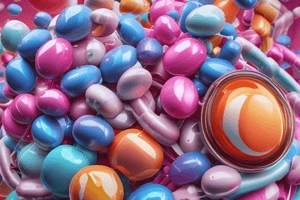Podcast
Questions and Answers
What type of packaging is most suitable for drugs that are sensitive to moisture?
What type of packaging is most suitable for drugs that are sensitive to moisture?
- Amber-colored bottles
- Opaque glass containers
- Plastic vials with no seals
- Moisture resistant packaging, such as blisters (correct)
Which of the following factors does NOT affect drug stability in formulations?
Which of the following factors does NOT affect drug stability in formulations?
- Exposure to light
- Chemical compatibility with excipients
- Cost of manufacturing (correct)
- Storage temperature
For drugs sensitive to oxygen, which of the following is a suitable precaution to enhance stability?
For drugs sensitive to oxygen, which of the following is a suitable precaution to enhance stability?
- Increasing the moisture content
- Using a transparent container
- Reducing the dosage frequency
- Including anti-oxidants in the formulation (correct)
Which of the following properties is crucial for ensuring large-scale manufacturing of pharmaceuticals?
Which of the following properties is crucial for ensuring large-scale manufacturing of pharmaceuticals?
When considering the appropriate dosage form for a drug, which factor is generally the least relevant?
When considering the appropriate dosage form for a drug, which factor is generally the least relevant?
What is the primary objective of designing dosage forms?
What is the primary objective of designing dosage forms?
Which of the following factors is NOT considered before formulating a drug into a dosage form?
Which of the following factors is NOT considered before formulating a drug into a dosage form?
What is the primary method of drug absorption through biological membranes?
What is the primary method of drug absorption through biological membranes?
Which dosage form is typically used for oral administration?
Which dosage form is typically used for oral administration?
What is a major disadvantage of the oral route of drug administration?
What is a major disadvantage of the oral route of drug administration?
Which route of drug administration is associated with the slowest onset of action?
Which route of drug administration is associated with the slowest onset of action?
Which of the following is a consideration in the biopharmaceutical factors affecting drug absorption?
Which of the following is a consideration in the biopharmaceutical factors affecting drug absorption?
Which administration route uses aerosols for drug delivery?
Which administration route uses aerosols for drug delivery?
Which of the following factors influence the acceptability of a drug dosage form to patients?
Which of the following factors influence the acceptability of a drug dosage form to patients?
What role does particle size play in drug formulation?
What role does particle size play in drug formulation?
What is the primary route of absorption for drugs administered topically?
What is the primary route of absorption for drugs administered topically?
When formulating a drug in a semi-solid base, which of the following is a crucial factor?
When formulating a drug in a semi-solid base, which of the following is a crucial factor?
Which aspect of respiratory routes for drug administration enhances absorption?
Which aspect of respiratory routes for drug administration enhances absorption?
What is an important characteristic of drugs intended for systemic effect through the skin?
What is an important characteristic of drugs intended for systemic effect through the skin?
How does micronization affect drug stability?
How does micronization affect drug stability?
Why is aqueous solubility important for drug efficacy?
Why is aqueous solubility important for drug efficacy?
Flashcards
Dosage Form Design
Dosage Form Design
Designing a drug delivery system to achieve a predictable therapeutic response and large-scale production with consistent product quality.
Biopharmaceutical Considerations
Biopharmaceutical Considerations
Factors affecting drug absorption from different administration routes. Considering how a drug enters the body.
Drug Factors
Drug Factors
Physical and chemical properties of the drug itself, influencing formulation.
Therapeutic Considerations
Therapeutic Considerations
Signup and view all the flashcards
Oral Route
Oral Route
Signup and view all the flashcards
Absorption Mechanisms
Absorption Mechanisms
Signup and view all the flashcards
Biopharmaceutics
Biopharmaceutics
Signup and view all the flashcards
Disadvantages of Oral Route
Disadvantages of Oral Route
Signup and view all the flashcards
Drug Stability
Drug Stability
Signup and view all the flashcards
Packaging & Stability
Packaging & Stability
Signup and view all the flashcards
Drug Decomposition
Drug Decomposition
Signup and view all the flashcards
Dosage Form Factors
Dosage Form Factors
Signup and view all the flashcards
Patient-Related Factors
Patient-Related Factors
Signup and view all the flashcards
Topical Drug Delivery
Topical Drug Delivery
Signup and view all the flashcards
Percutaneous Absorption
Percutaneous Absorption
Signup and view all the flashcards
Local Drug Effect
Local Drug Effect
Signup and view all the flashcards
Ointments, Creams, Gels
Ointments, Creams, Gels
Signup and view all the flashcards
Respiratory Route Delivery
Respiratory Route Delivery
Signup and view all the flashcards
Particle Size (Drug)
Particle Size (Drug)
Signup and view all the flashcards
Drug Solubility
Drug Solubility
Signup and view all the flashcards
Organoleptic Properties (Dosage Form)
Organoleptic Properties (Dosage Form)
Signup and view all the flashcards
Study Notes
Dosage Form Design
- The principal objective of dosage form design is to achieve a predictable therapeutic response for a drug, producing a formulation suitable for large-scale manufacture with reproducible quality.
- Different dosage forms are designed for various delivery routes to maximize therapeutic response.
Administrative Routes and Dosage Forms
- Oral: Tablets, capsules, suspensions, solutions, emulsions, powders, effervescent powders
- Rectal: Suppositories
- Topical: Ointments
- Parenteral: Injections (subcutaneous, intramuscular, intravenous)
- Lungs: Aerosols, inhalations
- Nasal: Inhalations
- Eye/Ear: Solutions, suspensions
Factors Considered in Dosage Form Design
- Biopharmaceutical Considerations: Factors impacting drug absorption from different administration routes.
- Drug Factors: Physical and chemical properties of the drug.
- Therapeutic Considerations: Disease to be treated, patient factors (age, sex, etc.).
Pathways of Drug Administration
- Drugs are absorbed through various pathways after administration, affected by different aspects of dosage forms including the delivery route.
- Following administration, drugs can travel through the gastrointestinal tract, circulate in the vascular system, affect the respiratory system, and interact with the skin, before being eliminated.
Biopharmaceutical Considerations
- Biopharmaceutics studies the relationship between physical, chemical, and biological sciences for drug application.
- Drug must be in solution to dissolve into absorbing membranes of the skin, gastrointestinal tract (GI tract), and lungs.
- Drugs penetrate membranes through passive diffusion or specialized transport mechanisms.
- Passive diffusion is driven by concentration gradients; specialized transport methods may require an energy source.
Routes of Drug Administration
- The main routes of drug administration include oral, rectal, parenteral, topical, and respiratory.
1. Oral Route (p.o.)
- Oral administration is frequently used for systemic effects.
- Drugs dissolve in the GI tract, leading to rapid absorption.
- It's the simplest, most convenient, and safest method.
- Disadvantages: Slow onset of action, irregular absorption, and destruction by GI enzymes/secretions (e.g., insulin). Gastric emptying time affects drug absorption. Stomach and large intestine pH differently affect drug ionization and lipid solubility, impacting drug absorption. Membranes are more permeable to unionized forms.
2. Rectal Route
- Used more often for local effects than systemic.
- Suppositories are introduced into cavities (e.g., rectum) and melt, releasing the drug.
- Rectal route is important for drugs inactivated by the oral route, or when the patient is vomiting or unconscious.
- Drug administered rectally may bypass the liver, offering advantages.
- A disadvantage is irregular drug absorption.
- Rectal medications are typically administered in solution, suppository, or emulsion forms.
3. Parenteral Route
- Drugs are injected via a needle into the body at different sites and depths.
- Subcutaneous, intramuscular, and intravenous routes are the three main types.
- Rapid absorption occurs, making it beneficial for emergency situations, unconscious patients, or when drugs are deactivated or poorly absorbed orally.
- This route offers more predictable blood levels than oral administration and is delivered as sterile solutions/suspensions in water or an appropriate vehicle.
4. Topical Route
- Drugs are applied to the skin for local effects.
- Drug absorption occurs through sweat glands, hair follicles, and the stratum corneum, however percutaneous absorption is erratic.
- Can be employed for local application or, in some cases, for systemic effects (e.g., transdermal patches).
- Pharmaceutical topical formulations often involve the drug in semi-solid bases (ointments, creams, pastes), gels, lotions, and solutions.
5. Respiratory Route
- Drugs are delivered to the lungs in gaseous or aerosol form.
- The particle size of the drug affects absorption, impacting treatment efficacy.
- Useful for treating asthma with powder aerosols or metered aerosols.
- This route is now used for administering peptides and proteins unsuitable for oral administration.
Drug Factors
- For stable and efficacious products, studying drug properties (physical and chemical) is crucial.
Organoleptic Properties
- Dosage forms must be acceptable to patients.
- Drugs can be unpalatable in their natural form.
- Flavour and perfumes are necessary for liquid oral dosage forms and may be useful in solid dosage forms (e.g., bitter taste masks).
- Colour changes can complement flavour, modify appearance, and sometimes improve safety.
Particle Size and Surface Area
- Drug particle size relates to surface area.
- Fine subdivision increases availability for poorly soluble drugs.
- Drug dissolution rates can be influenced by excipients in the formulation.
- Excessive micronization/size reduction alters crystal and energy properties.
Drug Solubility
- Drugs must have limited aqueous solubility to lead to complete absorption.
- More soluble salt or ester forms of drugs might be employed to increase bioavailability.
- Salts can precipitate in the gastrointestinal tract.
- pH dependency of solubility influences drug activity and may be a concern.
Drug Dissolution
- Drugs must dissolve in the absorbing medium for absorption.
- Noyes-Whitney equation describes drug dissolution (dm/dt = KA(Cs – C)) considering the dissolution rate constant (K), surface area of solids, the concentration of drug in saturated layer and the concentration of drug in dissolution medium at a given time.
Partition Coefficient & pKa
- Relatively insoluble compounds have dissolution that acts as the rate-limiting step in absorption.
- The rate of permeation through biological membranes is often rate determining for some soluble drugs.
- Partition coefficient (o/w) is a measure of the lipophilic characteristic of drugs.
- Absorption membrane actions are mediated by lipophilic, partitioning nature of drugs.
- The absorbing membrane is more permeable to the unionized form of drugs rather than the ionized forms because of the greater lipid solubility and the charges of the cell membrane components.
Crystal Properties and Polymorphism
- Drug substances can be amorphous (without a lattice) or crystalline (organized lattice), with either an anhydrous or hydrated structure.
- Drugs can exist in different crystal forms (polymorphism).
- Polymorphic forms have different physical properties, impacting solubility, dissolution, and stability.
Stability
- Drug stability pertains to the chemical stability and compatibility with excipients.
- Formulation elements must maintain stability, especially in relation to degradation from elements like light, heat, or moisture, in order to preserve therapeutic potency.
- Appropriate packaging and consideration for moisture resistance, antioxidants, light sensitivity, pH, and preservatives will sustain the product's stability.
Other Properties
- Properties suitable for manufacturing procedures and large-scale manufacture (flowability, hygroscopicity, compressibility) are critical considerations.
Processing Stresses
- Processing stresses (temperature, pressure, mechanical forces) can affect several properties impacting the manufacturing protocol and associated procedures (e.g., crystallization, precipitation, filtration) and stability of the drug substance.
Therapeutic Considerations
- The nature of the illness, systemic vs. local effects, duration of action, emergency situations, and patient factors (age, weight, physiological/metabolic status) influence the required dosage form.
- Drugs must specifically target the disease area, employing specialized dosage forms (e.g., liposomes, nanoparticles) appropriately.
Studying That Suits You
Use AI to generate personalized quizzes and flashcards to suit your learning preferences.




